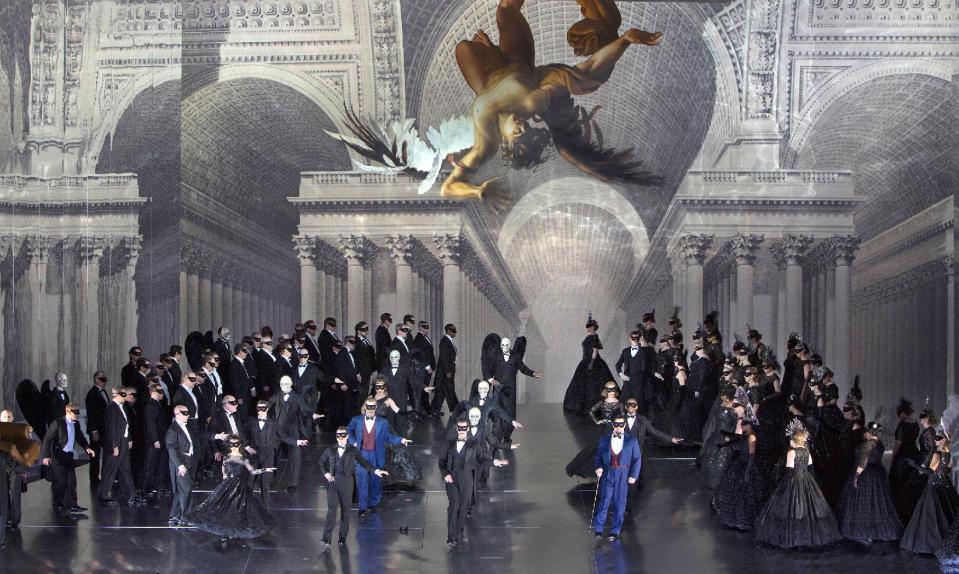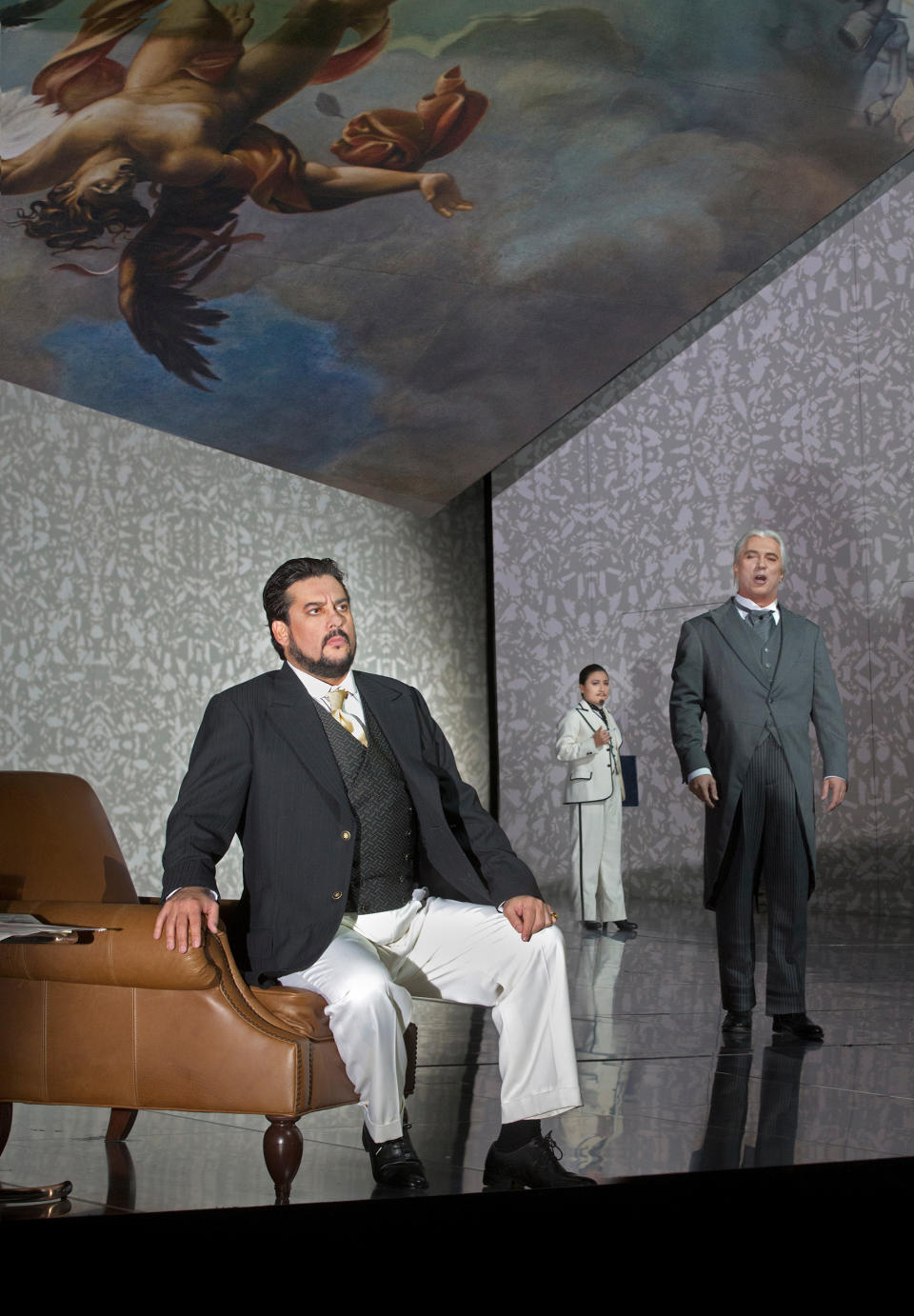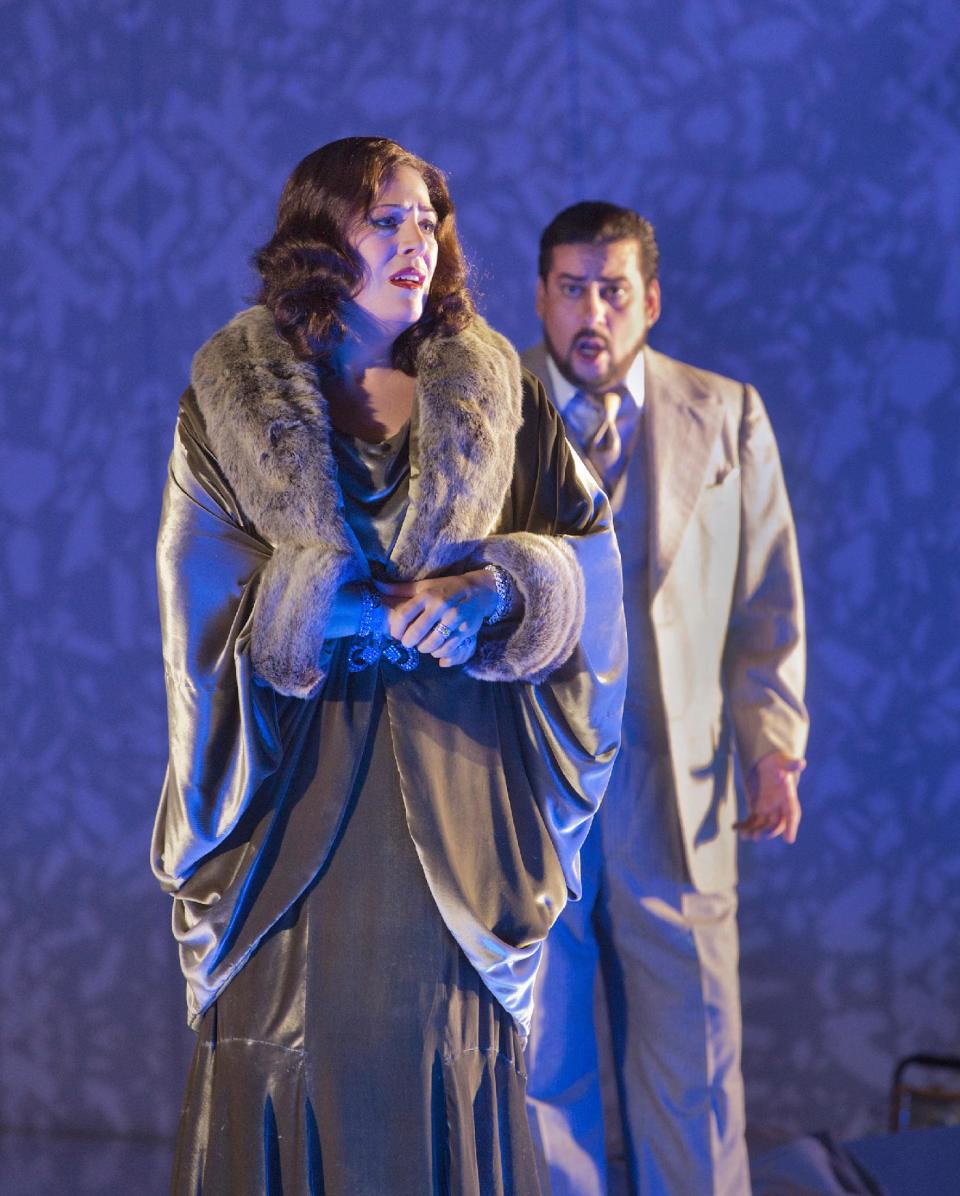Review: David Alden gives Met new vision of Verdi
NEW YORK (AP) — Part film noir, part surrealistic nightmare, David Alden's new production of Verdi's "Un Ballo in Maschera" is dominated by a single image — a painting of Icarus plunging toward his death after flying too close to the sun and melting his waxen wings.
It's an image that asks the viewer to compare the opera's main character, King Gustavo III of Sweden, to the mythological hero, both undone by pride and reckless daring. And it challenges us to think past the improbable melodrama of jealousy, betrayal and revenge that forms the surface of one of Verdi's most brilliant and beloved operas.
That's a challenge the Metropolitan Opera audience at Thursday night's premiere was only partly ready to accept. When the director and his team came out to take their curtain calls, they were greeted with a mixture of bravos and boos, about in equal measure.
There were nothing but cheers, however, for the unusually well-balanced group of singers who filled the five leading roles. For Sondra Radvanovsky in the role of Amelia, the night was a special triumph, her powerful, penetrating voice filling the house with refulgent sound. Tenor Marcelo Alvarez, animated and ardent as Gustavo, sang with rich, smooth tone and exciting high notes — though he attacked some of them overemphatically. As his friend and councillor Anckarstroem, the elegant baritone Dmitri Hvorostovsky made his great aria "Eri tu" a high point of the evening. Soprano Kathleen Kim, bedecked with goatee and mustache, sparkled in the "trousers" role of the king's page, Oscar, though she got swallowed up in the ensembles. And mezzo-soprano Dolora Zajick brought her usual imposing tones at either end of her vast range to the role of the fortuneteller Ulrica. The chorus sang with gusto.
Fabio Luisi, the Met's principal conductor, led a performance that was precise and well-paced, although at times a greater sense of urgency would have been welcome.
In Alden's vision, Gustavo both defies death and courts it through his reckless pursuit of Amelia, who is married to Anckarstroem. The king sees all too clearly what's coming: When toward the end of the opera, Oscar brings him a note warning of a plot against his life, he knows the contents before he reads it.
This Gustavo is quite a showman as well — joining Oscar in an inspired soft-shoe routine with top hat and cane at the end of the opening scene. In the next scene, he goes disguised as a sailor to investigate Ulrica, and when she foretells his death, he laughs at the prophecy in an aria that's staged as a display of bravado designed to entertain the crowd.
In Alden's vision, the entire opera can be viewed as something the king dreams while reclining in a leather armchair in his sitting room. Icarus confronts him at every turn — starting with the curtain that rises during the prelude. A similar painting hangs overhead at a precarious angle in the opening scene and in most subsequent ones as well. The one time it's missing is inside Anckarstroem's house as he plots Gustavo's murder. Paul Steinberg's set here is a claustrophobic, asymmetrical black-and-white box, and the only picture is a portrait of Gustavo on the wall. Anckarstroem later yanks it off in a rage, and one of his fellow conspirators defaces it.
This scene is particularly striking visually, as is the final scene during the masked ball that gives the opera its title. Mirrored walls on the sides of the stage lead to a rear backdrop that suggests a magnificent palace like Versailles. Courtiers in disguise — including several angels of death with large black wings — parade to choreography by Maxine Braham. Oscar wears white wings for his costume until they are ripped off by another guest.
Adam Silverman's evocative lighting helps create the phantasmagorical mood, while Brigitte Reiffenstuel's modern-dress costumes make the characters look as though they popped out of a 1940s Hollywood movie.
Though Verdi based "Ballo" on an actual assassination of a Swedish monarch, Italian censors in his day forced him and librettist Antonio Somma to switch the action away from Europe. The story was moved to colonial Boston, where Gustavo became Riccardo and Anckarstroem, Renato. This production returns to the original setting.
Not everything comes through with the clarity Alden likely intended. Some bits seem muddled and overdirected, like the frantic behavior of the courtiers in the opening scene, carrying their desks and chairs on and off the stage and staring obsessively at their own white-gloved hands. And the Icarus symbolism is so pervasive, it ultimately risks becoming heavy-handed.
Still, this is an intriguing fresh look at one of the essential works of the repertory. And Alden, an American who has directed extensively in Europe but never staged a new production at the Met, is a welcome iconoclastic presence.
There are nine more performances. Stephanie Blythe takes over as Ulrica for the final five, and soprano Amber Wagner sings Amelia at the last performance on Dec. 14. The matinee on Saturday, Dec. 8, will be shown live in HD in movie theaters worldwide.



